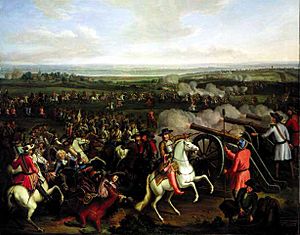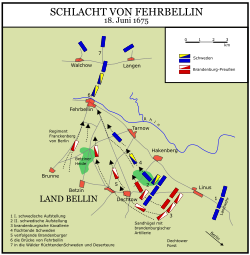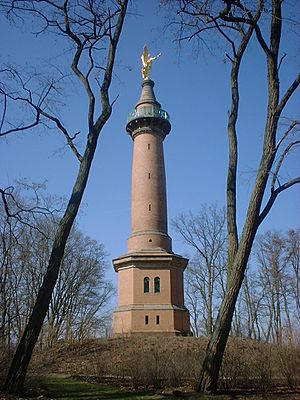Battle of Fehrbellin facts for kids
Quick facts for kids Battle of Fehrbellin |
|||||||
|---|---|---|---|---|---|---|---|
| Part of the Scanian War (Northern Wars) Franco-Dutch War |
|||||||
 The Battle of Fehrbellin by Dismar Degen |
|||||||
|
|||||||
| Belligerents | |||||||
| Commanders and leaders | |||||||
| Strength | |||||||
| 6,000–7,000 men, 13 cannons |
7,000, 28 cannons |
||||||
| Casualties and losses | |||||||
| 500 killed and wounded | 500–600 killed, wounded and captured | ||||||
The Battle of Fehrbellin was a major fight on June 18, 1675. It took place between the armies of Sweden and Brandenburg-Prussia. The Swedish forces, led by Count Waldemar von Wrangel, had moved into parts of Brandenburg. But they were pushed back by the army of Frederick William, known as the Great Elector. His army was led by his trusted general, Georg von Derfflinger.
This battle happened near the town of Fehrbellin. It was a very important victory for Frederick William. It helped show how strong his army was becoming.
Contents
Why the Battle Happened
Before this battle, Sweden and Brandenburg had actually been friends. They fought together in wars against the Kingdom of Poland. However, things changed when Frederick William joined a group of allies. They went to fight against King Louis XIV of France in a war called the Franco-Dutch War.
While Frederick William's army was away, France convinced Sweden to attack Brandenburg. Sweden was feeling a bit alone in Europe at the time. So, they agreed to invade Brandenburg.
The Great Elector's Fast March
Frederick William was far away when he heard about the Swedish attack. A large part of his land was taken over in December 1674. He quickly pulled his army out of the war in France.
He then made an amazing journey. On May 26, 1675, he started marching his army. They covered about 250 kilometers (155 miles) in just two weeks! This was seen as one of the greatest marches in military history. He did this by leaving behind his supply wagons. His army bought food from local people instead of taking it. The Swedes did not expect him to arrive so quickly.
Tricking the Swedes at Rathenow
When Frederick William got back to Brandenburg, he saw that the Swedish forces were spread out. They were in a swampy area. He told General Derfflinger to capture the town of Rathenow. This would split the Swedish army in half.
The speed of the Elector's army and a clever trick kept the Swedes from knowing he was there. General Derfflinger, who was 69 years old, led an attack on Rathenow. He had 7,000 cavalry (soldiers on horseback) and 1,000 musketeers (soldiers with guns). Heavy rain helped hide their approach.
Derfflinger pretended to be a Swedish officer. He convinced the guards to open the town gates. He claimed a Brandenburg patrol was chasing him. Once the gates were open, he led 1,000 dragoons (soldiers who ride horses but fight on foot) into the city. The rest of the army quickly followed.
After Derfflinger took Rathenow, the Swedish commander Wrangel pulled his troops back. They headed towards Havelberg. Their journey was very hard because summer rains had made the marshes muddy and dangerous.
On June 17, the Brandenburg troops reached Nauen. Frederick William's advance teams, guided by locals, blocked the ways out of the area. The Swedes had planned to cross the Elbe river. They wanted to meet up with other troops. But they were forced back to their last strong position at Fehrbellin.
The Battle of Fehrbellin
The Swedish commander, Wrangel, found himself stuck. A bridge over the Rhin river near Fehrbellin was destroyed. On both sides of his army were impassable marshes. This left Wrangel with no choice but to fight south of a village called Hakenberg. His engineers worked hard to fix the bridge.
The Brandenburg army had 6,000 to 7,000 soldiers and 13 cannons. The Swedes had 7,000 soldiers and 28 cannons. Wrangel made a mistake by not protecting the higher ground around them. Frederick William and Derfflinger quickly put their cannons on some low hills to the left of the Swedish army. The Swedes only had swamps on their sides and a river behind them. This gave Brandenburg a huge advantage.
Fighting Begins
The Brandenburg cannons started firing around noon on June 18. They caused a lot of damage to the Swedish right side. Wrangel realized the danger. He tried many times to take control of the hills. But the Brandenburg cavalry stopped him each time.
This fighting went on for several hours. Then, Frederick William ordered his main attack to push hard on the Swedish right side. This caused the Swedish cavalry to run away. The Brandenburg cavalry, led by Prince Frederick II of Hesse-Homburg, then turned. They attacked the Swedish infantry (foot soldiers) who were now unprotected.
However, the Swedish right side had held on long enough for the Fehrbellin bridge to be fixed. Wrangel was able to get a large part of his army across the river before night fell. Frederick William decided not to attack the town itself.
Who Won and What They Lost
The Brandenburg troops lost about 500 men. Wrangel's forces lost a bit more, but the exact number is not clear. The Swedish infantry lost 300 to 400 men. Another 200 losses were mostly from their cavalry. In total, the Swedes lost about 500 to 600 soldiers who were killed, wounded, or captured in the battle.
Wrangel lost many more men in the days that followed. This was due to the Brandenburg troops chasing them. Also, local farmers, who remembered bad things the Swedes had done in the past, attacked them. Near Wittstock, about 300 Swedes were killed by these farmers. By July 2, there were no more Swedish soldiers left in the area.
Why Fehrbellin Was Important
On the day of the battle, the Swedes just wanted to join their forces and leave. They managed to do that. The Brandenburgers wanted to stop them, which they didn't fully achieve. But the battle still became a turning point. In military tradition, the side that controls the battlefield at the end is the winner. This was clearly the Brandenburgers. They quickly told everyone about their victory.
After Brandenburg won, other countries like the Holy Roman Empire and Denmark finally declared war on Sweden. Frederick William's forces then moved into Swedish lands. However, the Swedes did not come back into Brandenburg until 1679. A peace treaty largely put things back to how they were before the war. This was a big disappointment for the Elector.
The Great Elector's Legacy
The victory at Fehrbellin had a huge impact on people's minds. The Swedes had long been thought unbeatable. But Brandenburg had defeated them all by itself. This victory greatly boosted Frederick William, who was 56 at the time. He took an active part in the fighting. He even had to be rescued by his dragoons at one point.
From then on, Frederick William was known as the "Great Elector." The army he and Derfflinger led to victory became the heart of the future Prussian Army. This army was very important for Brandenburg to grow into a powerful country in Europe. The battle was celebrated in Germany as a holiday until 1914.
In Sweden, this defeat was a big reason why the king, Charles XI, gained more power in 1680.
See also
- Wars and battles involving Prussia
- Swedish invasion of 1674/1675



